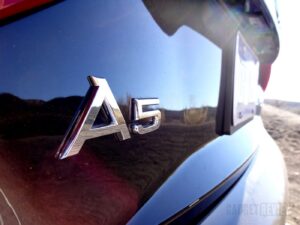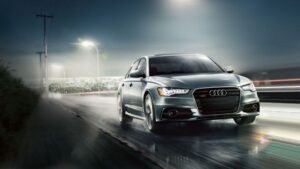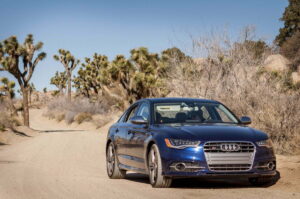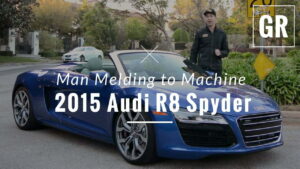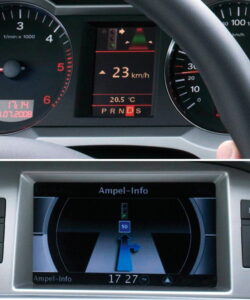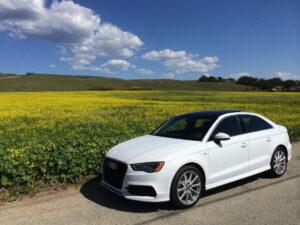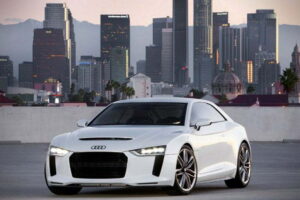Feast your eyes on the all new, second generation Q7. And I stress second generation, because the previous Q7 was the first, remaining in production for 10 years, receiving a few facelifts over its life. Take a look at our 2013 Audi A5 review to compare with an older Audi. Or, you can compare it with some of the best luxury cars.
Let’s get the powertrain out of the way. Taking this 4,938 lb car from 0-60 in 5.7 seconds is Audi’s very capable and responsive Supercharge 3.0L V6 which produces 333 hp. It’s mated to an 8-speed TipTronic gearbox. Top speed you ask? 130 mph. If you’d rather go with a luxury brand, take a look at our 2013 Cadillac XTS review.
Fuel economy is 19/25 city/highway or 21 combined. Where as the previous generation, which was fatter and less efficient, saw a 16/22 city/highway and 18 combined. So needless to say, a marked improvement.
Assisting with both ride comfort and drivability is an air suspension that can lower or raise the car for the driving scenario at hand – ground clearance can top out at 9.6-inches. But that’s not all. It can be used to gain entry into the rear. Adding to that is four wheel steering, which apparently improves stability on the highway, but more more importantly reduces turning radius by quit a bit. And yes, AWD, or Audi Quattro is standard.
Related: If you like this car, you might be interested in our 2015 Audi R8 Spyder review.
Now, if you haven’t noticed the outside of the Q7 has changed quite a bit. Gone are the smooth rounded lines, replaced by sharp edges. The Audi grill has also seen an update in the same capacity, offering a stronger, bolder facade that I prefer over the previous Q7. However, this Q7 does feel low and long, giving it a slightly van like look at certain angles. Nevertheless, it is sharp and high end looking, even garnering compliments from one valet at Zankou chicken in West LA. Hmmm. Love that Chicken!
On the inside some might call this a sumptous interior. Me? I call it game changing. Audi has out done itself and while the leather is plush and the interior atmosphere comfortable, it actually begins with a few, very notable tech upgrades.
For starters, they’ve finally built an intuitive climate control system that doesn’t require you to touch the MMI system. 4 zones are available at the Prestige level, accessible via these beautifully machined nobs that house what looks like be mini OLED displays. Draw your eyes up from there to the MMI system and you’ll find a crisp 8.3-inch color display that retracts into the car’s dash when the ignition is off. And while it’s arguably small for a vehiicle of this size, the driver only need to turn to the instrument cluster to find a 12.3-inch tft screen that Audi calls a Virtual Cockpit. It can show speed, directions and just about all the controls you’d need at your fingertips. And if that isn’t enough, there is a HUD for mph and turn-by-turn directions. But my money is on the Virtual Cockpit for usability, accessibiltu and clarity.
Related: Also take a look at our Lexus RX350 F Sport review.
This is complemented by the presence of Android Auto and Apple Car Play. You’ll just need to plugin using a USB cord and you’ll be off to the races. That said, my iPhone 6 worked without a hiccup and offered the usual range of apps and integration I’ve come to expect from the system.
Now, at this level, the Prestige, the top end of the packages, the Q7 comes with a Bose 3D sound system. That’s 19 speakers at 558 watts. It sounds good but not amazing. Though, to be fair, to fill this much space is no easy feat and will satiate most if not all Q7 owners. And for those looking for more, there is an optional $5,000 Bang and Olufsen system. You know, the one with the retractable speakers.
And speaking of space. The second row seats are adjustable. And…so are the third row. Which is to say, they can be laid flat or raised back into place with the push of a button. Cargo space is 71.6 cubic feet behind the first row, or 14.8 behind third row.
Other features include:
- A handwriting MMI system complemented by the usual knob. And yes, it’s still backwards
- 2x USB ports for connectivity and power
- Bluetooth
- Paddle shifters, though you likely won’t use them
- A panoramic sunroof
- A garage door opener, though it wouldn’t work with my system
- 10 beverage holders
- Twelve way power front seats with heating and cooling
- Electric fold and return 3rd row
- Cameras front, back and on the sides to provide a “top view”
- Blind spot monitoring
- Auto braking
And adaptive cruise. With the latter contributing, in tandem of course with lane assist, to provide almost automonous driving. Though, the system will nag you to put your hands back on the steering wheel if it detects congestion. But with that, and its ability to read traffic signs, it can drive in traffic up to 37mph. Though for full disclosure I’m not sure we ever got this to work properly.
And if that isn’t enough, this Audi apparently leverages the computing power of 4 Nvidia Tegra processors. This allows the vehicle to talk among itself without any hicups in speed, supporting the MMI system, safety features, air suspension and more.
Now, you might be wondering how well the 2017 Q7 drives. The air suspension definitely lends itself to a smooth and comfortable cloud like ride. And within that adjustability, ranging from comfort to dynamic – the latter being Audi’s version of spirited. However, even in the most aggressive setting, which lowers the vehicle, there is still body roll that makes the Q7 feel sometimes lathargic. Comparativitly speaking, it doesn’t drive nearly as well as the full sized Range Rover. But who am I kidding. That car, at least the version we drove last year, was twice the price. Which is another way of saying, our Q7, all in, with all the options, is $73,425.
